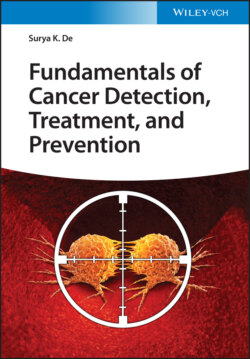Читать книгу Fundamentals of Cancer Detection, Treatment, and Prevention - Surya K. De - Страница 29
1.7.1 Tumor Suppressor Genes
ОглавлениеThe genes have the protective feature of controlling cell growth by:
Monitoring new cell divisions
Correcting DNA sequences that have mutated
Controlling cell death (apoptosis)
Examples include TP53 (tumor protein 53 or cellular tumor antigen p53, or referred to as p53), PTEN, RB1, and APC. When tumor suppressor genes mutate, cell growth is unchecked and may result in tumor formation.
In the case of germline mutations, if certain tumor suppressor genes – namely BRCA1 or BRCA2 – mutate, there is a higher chance of developing hereditary breast or ovarian cancer for women, and prostate cancer for men. These specific mutations also have been linked to an increased risk of pancreatic cancer and melanoma.
More than half of diagnosed cancers are caused by mutations that damage or disable gene p53 (Figure 1.6). This is a common acquired mutation. Much more rarely, germline p53 mutations occur with subsequent greater risk for many types of cancer in family members.
Figure 1.6 Structure of p53 tumor suppressor protein. p53 prevents cancer formation and acts as a guardian of the genome. Mutations in the p53 gene contribute to about half of the cases of human cancer.
Source: Juan Gärtner/Adobe Stock
.
